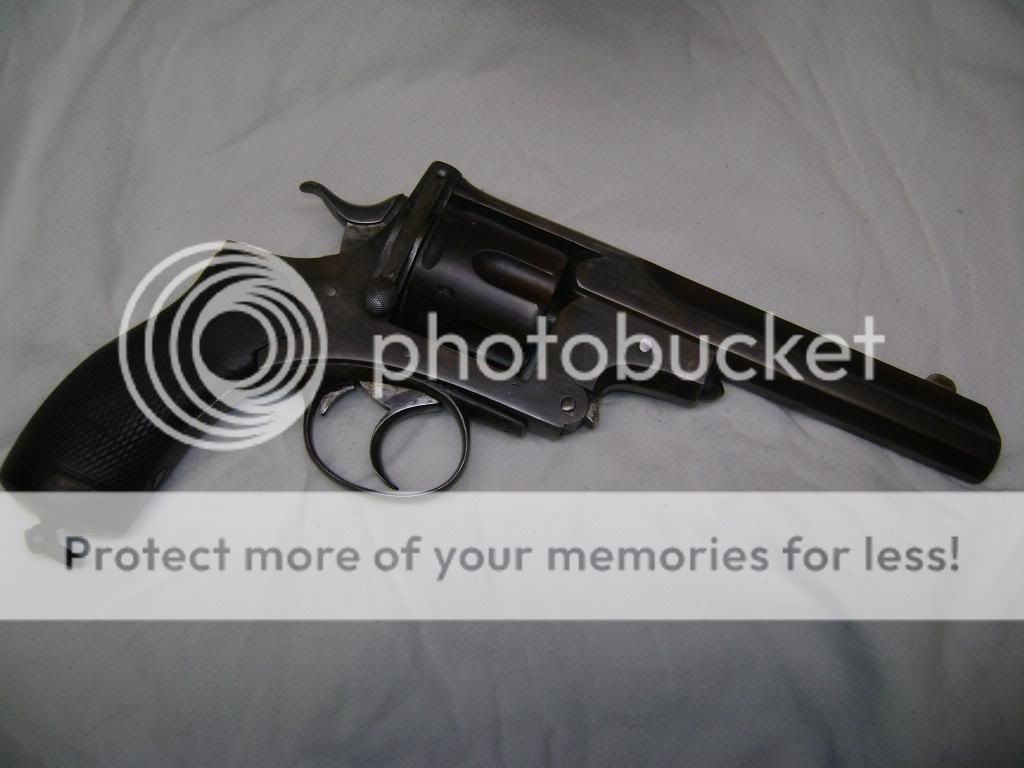The Goose
NES Member
I am not completely sure whether this is a milsurp or not. Certainly this revolver was not actually issued by the British War Department (WD). However, prior to about 1880 and even long afterwards, British officers typically bought their own revolvers or were gifted them when they started service. Even when the WD started issuing revolvers in the early 1880's it was the Enfield MK I and MK II, which were abysmal disasters. Most officers preferred to purchase their own. My particular revolver has a South African provenance and given the amount of wear on the grips I would say it saw some use. Of course I would like to fantasize that it was used in the Zulu or Boer wars, but I have no way of knowing. It probably belonged to some baker who liked to plink a lot in his spare time. Regardless it is a good example of the type of revolver that would have been carried by a British oifficer at that time. So I belive this is the right section for this post.
Webley acquired the Pryse patent in 1876 and this was their first breaktop revolver. The latch to open is a tong type arrangement. Later this type of design with some alterations became synonymous with Webley and their final MK VI model saw use until around 1960 or so. My Webley Pryse is chambered for .476 Enfield or Eley which is pretty much interchangeable with the .455. I managed to get a few hundred pieces of .476/.455 brass from Buffalo Arms Co. (BACO) and I picked up an RCBS mold for a 265 gr. hollow base bullet. The actual .476 had a heel based bullet, but the RCBS mold is pretty much a dublicate of the early .455 bullet. I slugged the bore and got .457. The bullets I cast are 50% 20:1 alloy and 50% pure lead, a pretty soft mix designed to "bump up" when fired. The bullets are .456 as dropped from the mold and I sized them in a .45-70 .458 die just to put the SPG lube in the grooves. They are loaded over 19 grs of Goex 2F with a .30 Walter's vegetable fiber wad. I used a drop tube and compression die to get the powder into the cases. I would have preferred 3F powder, but do not have any at the moment. We'll see how they do. Sitting here today looking at 2 feet of snow and still falling it is hard to picture ever getting to the range again, but that will change soon enough.







Webley acquired the Pryse patent in 1876 and this was their first breaktop revolver. The latch to open is a tong type arrangement. Later this type of design with some alterations became synonymous with Webley and their final MK VI model saw use until around 1960 or so. My Webley Pryse is chambered for .476 Enfield or Eley which is pretty much interchangeable with the .455. I managed to get a few hundred pieces of .476/.455 brass from Buffalo Arms Co. (BACO) and I picked up an RCBS mold for a 265 gr. hollow base bullet. The actual .476 had a heel based bullet, but the RCBS mold is pretty much a dublicate of the early .455 bullet. I slugged the bore and got .457. The bullets I cast are 50% 20:1 alloy and 50% pure lead, a pretty soft mix designed to "bump up" when fired. The bullets are .456 as dropped from the mold and I sized them in a .45-70 .458 die just to put the SPG lube in the grooves. They are loaded over 19 grs of Goex 2F with a .30 Walter's vegetable fiber wad. I used a drop tube and compression die to get the powder into the cases. I would have preferred 3F powder, but do not have any at the moment. We'll see how they do. Sitting here today looking at 2 feet of snow and still falling it is hard to picture ever getting to the range again, but that will change soon enough.









